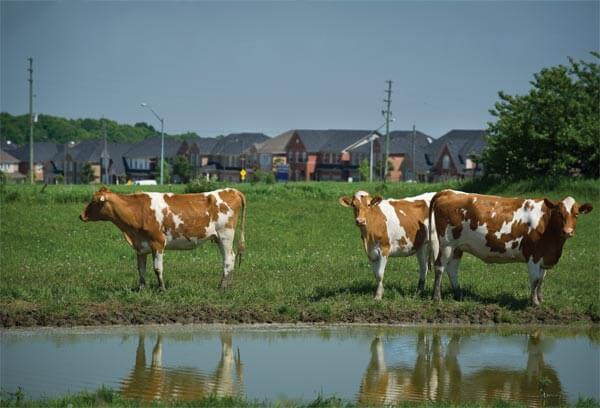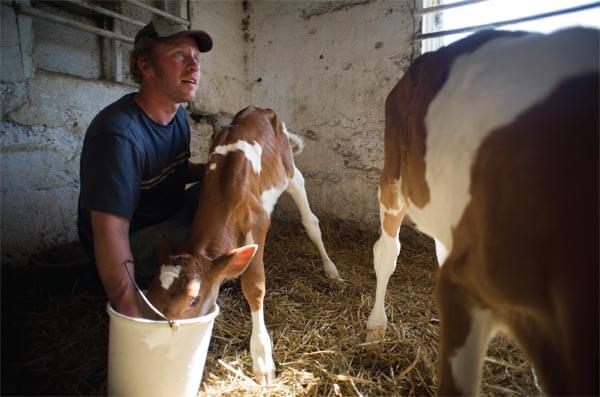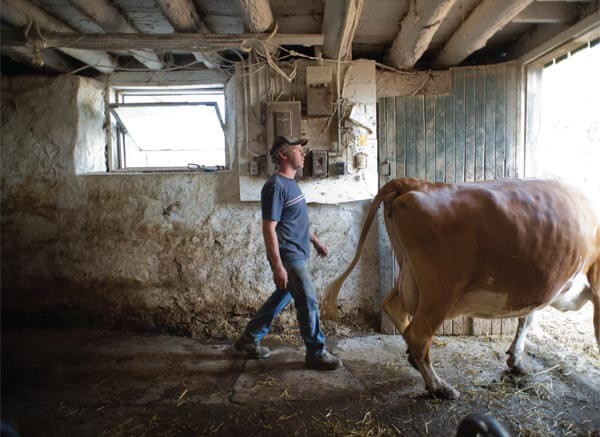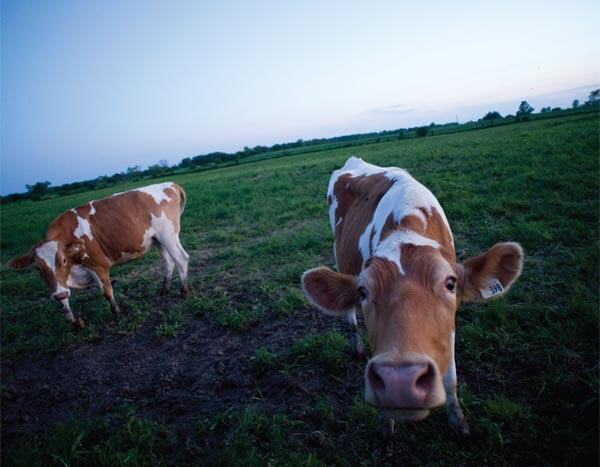How Ontario’s Greenbelt is failing farmers—and the local food movement
Chelsea Murray@chelsea_murray
The greenbelt saved 1.8 million acres of green space from urban sprawl. So why are the farmers who live and work there moving away?
Photos by Ian Willms

Robert Beynon’s dairy farm sits just north of the Toronto suburb of Richmond Hill, on one of the southernmost edges of Ontario’s greenbelt. It’s a small operation (40 cows, 350 acres) set back off of busy Bathurst Street. Behind his 150-year-old brick farmhouse and squat green dairy barn stretches a patchwork of bare fields, still muddy in mid-April. It’s the kind of pastoral scene city dwellers naturally think farms look like.
What those urbanites likely wouldn’t picture is what surrounds Beynon’s piece of rural paradise. Across the road, on the east side of Bathurst, sprawls MacLeod’s Landing, a 1,400-unit subdivision of looping streets and oversized homes. Houses bleed north onto former agricultural land—much of which Beynon’s family used to farm. He’d like to expand his property, but it’s boxed in on one side by the development, and on another by land slated to become a cemetery. Besides, he says, “The land’s too expensive, and you wouldn’t want to set up a bigger dairy operation next to a subdivision. Everyone loves the idea of living in the country, but they don’t really want to live beside somebody milking a couple hundred head of cows.” Later he wonders aloud, “And who wants to farm in the city when it comes down to it?”
Beynon is 33 years old; he’s no grizzled old-timer ready to retire. When he was still in school at the University of Guelph, taking a farm operations program, he and his father made plans to move outside of the GTA, away from the already encroaching houses, to buy more land and milk more cows. But in 2001, the Oak Ridges Moraine Act became law. (The moraine area’s 470,000 acres run from Brampton to past Cobourg.) The result was strict land-use regulations dictating how farmers could alter or expand their operations. There was also a moratorium on intensive development, but that didn’t stop construction on MacLeod’s Landing; the development was grandfathered because it had been approved before the moraine policy was created. There was no such provision for Beynon, whose family has owned its land for 150 years.
Then in 2005, the provincial government created the 1.8-million-acre greenbelt, which wraps itself around the Golden Horseshoe—running north of Toronto, Hamilton and their suburbs. (The greenbelt also includes the Niagara Escarpment, which bends down from the Georgian Bay to Niagara Falls, and encompasses the environmentally fragile Oak Ridges Moraine, the expanding Rouge Park, and the Holland Marsh.) Beynon claims his property value dropped about 70 percent. Now he and his wife Trina are stuck. “We don’t plan. We can’t justify putting an addition on our farm. And there isn’t more land to rent,” says Beynon, exasperated. “I’m not happy.”
Not that you would know that from his demeanour. Giving me a tour of his farm one April evening last year, he talks constantly, filling up silence and filling in detail. He opens the creaky wooden door to his dairy barn and calls to his big black lab, Jake, to follow him. Inside, his Guernseys chew their cud under the old barn’s low ceilings—the building, constructed around the same time as the farmhouse, has hardly changed in 40 years. “This barn’s dated,” says Beynon, more serious now. “Through the ’90s we were not improving our farm because what’s the point when you’re supposed to move? So we got behind on that and now we’re trying to play catch-up,” he says, explaining that he’s trying to modernize his barn—to make milking and cleaning more efficient— without spending too much money on facilities he still hopes to leave. “But it’s hard to make a business plan when you’re in our situation.” So for now he waits, hoping he finds an opportunity to sell his farm and move his operation out of the GTA.

Other farmers, fed up with the costs, the traffic, and the bureaucracy are doing exactly that, setting out for more open, less regulated, less occupied spaces to the south, east, and north. Some believe a mass exodus is inevitable, and that as agricultural land empties, it will be bought up by wealthy urbanites and made into 100-acre hobby farms. “Little by little, down in the greenbelt, some of those [farms] are going to become big estates. What happens then, to good, quality land?” asks retired veterinarian and dairy farmer Terry O’Connor. The promise of a sustainable, local food source for millions of Ontarians may be thwarted by the very policies designed to foster it.
How did this happen? Despite good intentions, the government made a false assumption about agriculture: just because you save the land doesn’t mean you save the farms. Without a well thought-out provincial agricultural policy implemented along with the greenbelt, those good intentions will remain wishful thinking, or even worse, the death knell for small-scale agriculture in the GTA. If things keep going this way, farmers warn, the future of the greenbelt will be one of large-scale industrial farms and barely productive hobby farms—the worst of both worlds.
“Ontarians will never have to fear that our access to food runs out. Unless we experience a nuclear holocaust, we will always have access to farm-fresh foods.” That’s Burkhard Mausberg, president of the Friends of the Greenbelt Foundation, paraphrased last summer by urban affairs magazine Spacing. “We have our own food basket in our backyard,” he said.
That’s the dream. In 2006, one year after the greenbelt was created, The Globe and Mail reported [PDF] that Municipal Affairs Minster John Gerretsen was happy with the result: the scheme was “strutting its stuff in that it’s curbing urban sprawl, protecting water supplies and ensuring land for food protection.” Four years later, the Toronto Star’s Christopher Hume chimed in: “There was much shouting and screaming at the time—most notably from certain developers whose fury knew no bounds—but half a decade later, the wisdom of the move has been widely acknowledged.”
The Friends of the Greenbelt Foundation, a nonprofit whose purpose is to promote the protected area, boasts on its website that “possibility grows in the Greenbelt,” and claims the area is the most diverse of its kind in the world, both ecologically and agriculturally. It’s certainly one of the largest. At 1.8 million acres, it beats out London U.K.’s 1.2-million-acre swath, B.C.’s 716,000 acres, and the Netherlands’ 395,368.
There’s also no doubt Ontario’s greenbelt has saved land from developers. Conservationists and the public cheered the promise of land staying pristine, frozen in time. In fact, supporters cheered so loudly, they barely heard the grumbling from farmers out in their fields. Farmers weren’t consulted until after the McGuinty government announced the policy, and even then, they claim, no one listened. Agriculture, farmers groused, came second to environmentalism.
While she makes clear that she’s a staunch greenbelt supporter, food journalist Margaret Webb says, “When the local food movement gained momentum a few years ago, my perspective was that no one was really talking about the farmers… I think there was a misunderstanding of how farmers need to make a living.”
“We’re lashing out at the greenbelt because it’s the last insult,” says Niagara-area grape grower Howard Staff. “They should have talked about viability and programs that should have kept farmers in business.”

On the phone from his mid-town Toronto office, Mausberg—a former University of Toronto environmental studies professor and Ivey Foundation environmental director—says need for land protection was dire. “There was enormous growth eating up the land. Every year [in the GTA] we lost the equivalent of 1,200 soccer fields”—about 2,400 acres.
According to University of Toronto researchers Felix Fung and Tenley Conway, Toronto is “one of the fastest growing regions in North America, with the annual population increase exceeding 1.5 percent between 1996 and 2001. It is estimated that an additional 3.7 million people will make the region their home by 2031.” It’s no coincidence the greenbelt was created around the same time as the Places to Grow Act, a province-wide planning program to better manage municipal growth.
The Greenbelt Act itself states that the policy was created “to sustain the countryside, rural and small towns and contribute to the economic viabilities of farming communities;” “to preserve agricultural land as a continuing commercial source of food and employment;” and “to recognize the critical importance of the agricultural sector to the regional economy.”
But nowhere in the act’s 5,000 words does it lay out policies that support agriculture in any concrete way. Farming near an urban area, with its traffic, lack of agricultural infrastructure, and high land prices is difficult and frustrating. Those problems weren’t caused by the greenbelt, but they should be ameliorated by it.
In August 2009, University of Guelph rural-planning professor Harry Cummings and two grad students released a detailed analysis of agriculture in the region. Using census data, they looked at agricultural change from 2001 to 2006 in the greenbelt, and compared it to the rest of Ontario. What they found was that, in those years, the greenbelt area lost 490 farms and 86,000 acres of farmland, and every livestock operation in the region was either experiencing more rapid decline or slower growth than those in the rest of the province. The number of pigs had decreased by 31 percent in the greenbelt versus 14 percent elsewhere in Ontario, and the number of greenbelt beef cattle dropped by 24 percent versus 13 percent. The number of dairy cattle in the greenbelt fell by 13 percent versus 9 percent. (London, England’s greenbelt, created in 1939, faced a similar problem in the mid-1980s. High land prices forced farmers to rent land rather than own, and according to three University College London researchers, the percentage of family-run farms dropped from 45 percent in 1970 to 29 percent in 1985.)

Mausberg isn’t convinced by Cummings’ research. He says the numbers present a cause and effect relationship between the greenbelt and the flight of farmers that doesn’t actually exist. He calls Cummings’ research shoddy (something he’s even told the researcher himself), explaining that Cummings’ team studied census data from 2006, even though the greenbelt was only implemented the year before. “When you look at animal agriculture, it’s the first to leave when urbanization comes close because the infrastructure for that kind of farming is too far,” he says. “Urbanization is the single largest reason why farmers move, not land-use regulations. If you want to keep livestock agriculture, then you need to grow the greenbelt.”
Cummings, however, believes his conclusions will be borne out when he redoes the study after the 2011 census. “The one thing I want to make clear is I never claim the 2006 data shows the impact of the greenbelt; I’m just showing what happened between 2001 and 2006,” he says. “I hope that in 2011 we’ll see some new agriculture being created in the greenbelt, but that’s not what I hear. In fact, what I hear is the province hasn’t chosen to have any special near-urban agricultural policy.”
While Toronto Regional Conservation Authority planner David Burnett says farmers are exempt from some regulations if there is no alterative (they could, for example, build that shed within 30 metres of the buffer zone for a waterway if there was nowhere else to build it), Cummings says it’s still a burden farmers aren’t able to carry. “Many of the people who are stronger environmentalists than they are agriculturalists haven’t thought of the implications of how we grow our food in a responsible manner and have a green countryside,” he says. “It’s a lack of comprehension about the total picture.”
On a stretch of secluded rural road about a 10-minute drive east of Kitchener lives dairy farmer Ken McNabb, his wife, Marie, and their three boys. I visit one morning in late spring, and McNabb takes me for a tour around his property, showing me the grove of giant, sheltering trees, a backyard swimming hole, and tidy, black-metal-clad barns. This is the alternative Toronto-area farmers are seeking. Marie is baking a batch of muffins when I arrive, and as we all sit at the kitchen table, McNabb, a lean 52-year-old with a kindly, matter-of-fact demeanour, tells me what it was like to move 40 cows, his farm machinery, and all of his family’s household belongings from Georgetown, about 15 kilometres west of Brampton, to New Hamburg: easy. Okay, maybe not easy. The process of packing up and hauling away their entire livelihood was stressful, but McNabb regrets nothing. They don’t have to deal with bumper-to-bumper traffic backed-up in front of their house (“You try to teach a 16-year old to get across four lanes of traffic with a tractor and a wagon”); they don’t have to worry about encroaching suburbs. And they can see the stars at night.
Though McNabb’s former property wasn’t inside the greenbelt, he faced many of the same problems farmers there do. He was too far from a lot of farm services like tractor mechanics, stable cleaners, and machinery repair services. And they owned only 88 of the nearly 300 acres they farmed, so he couldn’t expand. But unlike Beynon, McNabb was handed an easy way out. Farmers on either side of the greenbelt say that when the legislation was enacted, it was almost like someone drew an arbitrary line in the soil. It was hard to say why some were encompassed in the protected swath and why some were left out.
The McNabb farm ended up on the south side of the line, in the so-called white belt—land on the Toronto side of the greenbelt left ripe for development—and between April 2004, when he and Marie started thinking about moving, and February 2005, when they sold, the value of his farm nearly tripled, from $1,800 per acre to $5,200 per acre.
McNabb sold his land to a speculator. It’s still being farmed, but will inevitably be developed. While he seems sanguine about his own situation, he’s fatalistic about farming around the Golden Horseshoe. “Eventually everybody has to go. Everybody leaves at a different time for a different reason, but eventually they all have to leave,” he says. “Some tolerate it longer than others. It depends on where they are, who their neighbours are, and what traffic is on the road. But it’s not as easy to pursue agriculture in the greenbelt as it is out where we are.”
About 100 farmers, planners and environmentalists gathered at the Four Points Sheraton in Thorold, Ontario, near St. Catharines, on a Wednesday in March 2010, to talk about the greenbelt. The summit was a makeshift review of the policy, hosted by the Region of Niagara. Local MPPs Tim Hudak and James Bradley were invited, but didn’t show.
The Greenbelt Act won’t be up for official review until 2015, 10 years after it was passed, but farmers here have decided they want to be prepared. “Just because the province can’t review it doesn’t mean we can’t,” says Len Troup, chair of the tender fruit marketing board and one of the summit’s five panelists.
Some, like TRCA planner David Burnett, believe a lot of farmers are mad the greenbelt took away their retirement funds. “They thought that their retirement would be based on selling their farmland to a developer…they feel certain rights were taken away.” But that isn’t the main reason for farmers’ anger. On the contrary, they’re upset by the “browning” of the greenbelt as land slips out of agricultural production. Ultimately, they want the same things as the food activists: viable local agriculture, more access to local markets, and support from their communities and government.
Mausberg was also at the summit in March, and while he believes more conversation is needed among farmers, citizens, and the government, he doesn’t share all of farmers’ sentiments: he thinks they’re focused on the wrong problems. “If we start the conversation with why the greenbelt was terrible and how the government forced it on you, we’re not going to have a dialogue,” he says. “You can sit there and whine about the fact that this happened five years ago, or you can talk about it.”
Even if opposing groups do find common ground on the issue, fixing the greenbelt is going to take more than a simple review. Suggestions of ways to revamp the act read like a long wish list. Foodies like Webb and Toronto-based food writer Sarah Elton, author of the book Locavore, want a food policy; farmers want an agricultural policy—it’s something they’ve been asking for since the beginning. “It’s about time the government came out with a statement to the effect that agriculture is a needed industry in Ontario,” says GTA Agricultural Action Committee chair Peter Lambrick.
“Farmers have to get the sense that they’re actually wanted here and that they can make a living,” says Lambrick. “I think it will come, but whether it will be this generation that does it or the next is what we’re asking now.”